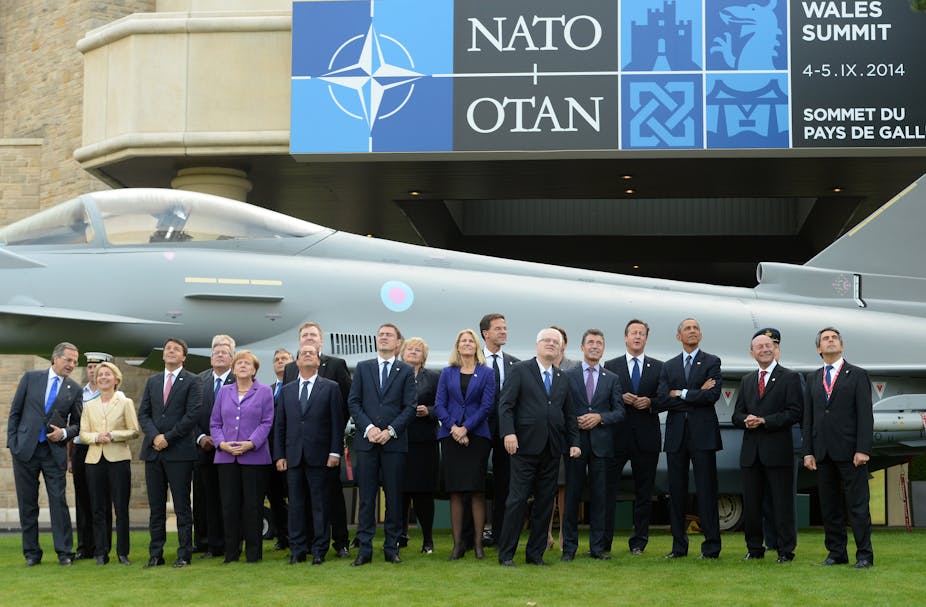NATO’s secretary general Anders Fogh Rasmussen is fond of saying that the alliance must now transform from a “deployed NATO to a prepared NATO”. But given the current crisis to its eastern flank, many are asking just how prepared NATO actually is to deal with an increasingly threatening and belligerent Russia.
The candid assessment delivered by General Sir Alexander Richard David Shirreff, the recently retired deputy supreme allied commander for Europe, might seem surprising:
I think NATO would find it very difficult to respond sufficiently quickly if, for example, Russia decided to attack and mount an airborne descent operation, for example, on Riga, Tallinn or Vilnius … the honest answer, as we speak now, is that NATO would be very pushed to respond sufficiently quickly in the event of a sudden surprise attack.
While a Russian conventional attack on a NATO member remains unlikely, if one were to occur, a Baltic state would most likely be the target. That’s not just because of Russia’s geographical proximity to Estonia, Latvia and Lithuania; Putin’s recent declarations that Russia will “actively defend the rights of Russians, our compatriots abroad, using the entire range of available means” is also alarming, since the Baltics harbour populations who precisely fit Putin’s rubric.
What worries NATO defence planners is not so much a conventional Russian attack on a member state, but the use of so-called “hybrid war” techniques. This term refers to a combination of military (both symmetrical and asymmetrical) and non-military tactics. Or, as one Russian military official described the approach, “The broad use of political, economic, informational, humanitarian and other non-military measures.”
New threats
Article 5 of the North Atlantic Treaty was designed to deter a conventional attack on the soil of one or more member states, but, there is an increasing realisation that NATO is just not currently structured or equipped to counter a challenge that would most likely be more asymmetric in nature.
The real fear is that asymmetric or hybrid schemes would skirt the usual trigger points for an Article 5 response.
The most obvious example of this is in the cyber domain, and accordingly, NATO leaders updated their collective defence article to include cyber threars at the Wales Summit this week.
But for NATO to project a credible deterrent, it needs to go much further than a line in a Communiqué referring to cyber threats. Fundamentally, it must recalibrate towards both collective defence and out-of-area security challenges. For this to happen, a few important decisions and steps must be taken.
Stepping up
NATO needs to permanently base troops on the territory of one of its eastern member states, and fair and credible criteria for burden-sharing must be applied. That means that while embedded US forces will of course be needed to achieve collective defence credibility, European allies will have to contribute troops and resources too for the burden to be equitably shared.
The announced plan to agree a NATO response force in eastern Europe is a good first step. Increasing defence budgets in a way that also reflects equal burden-sharing across the alliance would be another.
The Wales Summit Declaration has approved a “NATO Readiness Action Plan” with a “continuous air, land and maritime presence … in the Eastern part of the alliance.” It also set out an agreement to reverse declining defence budgets, aiming for all members to meet the alliance’s guideline spend of 2% of GDP per year “within a decade.”
Although the target of all member states spending 2% of their GDP on defence remains somewhat unrealistic, that the Wales Summit has seen the NATO Command Structure updated, and developing an exercise programme that includes “hybrid warfare” threats is an encouraging sign.
All laudable declarations, then – but it should also be noted that this is not a legally binding document. The 2% target, too, was already agreed once before, in 2006. NATO has to face up to critical challenges when it comes to spending and burden-sharing, but it also must face up to the short-term task of simultaneously winding down operations in Afghanistan while transforming to becoming a “NATO prepared”.
The alliance’s members must surely realise that if they don’t address the imbalances in its collective defence posture, NATO’s relevance will be fundamentally damaged – maybe even with devastating short-term consequences.
As they make their way home with their Welsh goody bags, the alliance’s 28 leaders should remember this much: for NATO, failing to plan is planning to fail.

